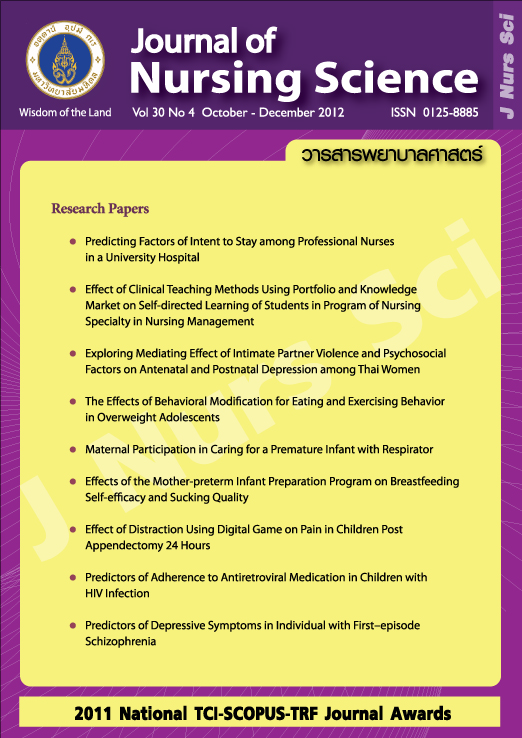The Effects of Behavioral Modification for Eating and Exercising Behavior in Overweight Adolescents
Main Article Content
Abstract
Purpose: To study the effects of eating and exercising behavioral modification program on standard weight for height, eating behavior, exercise and physical activities, calories intake and energy distribution in overweight adolescents.
Design: Quasi-experimental study.
Methods: Using convenience sampling, 120 grade 7 students with overweight were recruited from 2 schools randomly sampling from those under the Bangkok Educational Service Area Office 3. The subjects were divided into the experimental and control groups with 60 each. The students’ weight, height, %weight for height, eating behavior, food diary, and activity record were assessed at the beginning and at the end of the study. The experimental group was enrolled in a 30-week eating and exercising behavioral modification program with periodic follow-up by the researchers. Focus groups were also held for the parents and teachers. Data were analyzed using t-test, Mann-Whitney U test, and Wilcoxon Signed Ranks Test.
Main findings: At the end of the study, 87 participants remained in the study with 46 in the experimental group (25 male, 21 female) and 41 in the control group (25 male, 16 female). The results revealed that there was no significant difference between the study groups on standard weight for height, eating behavior, exercise and physical activities, calories intake and energy distribution (p > .05). However, the with-in group analysis showed significant differences in % weight for height and eating behavior in the experimental group; a significant decrease of exercising behavior in the control group.
Conclusion and recommendations: Nurses should apply the eating and exercising behavioral modification program in lowering the risk of obesity in adolescents. Long-term follow-up should also be taken as to maintain a proper eating behavior.
Keywords: adolescents, eating behavior, exercising, overweight
บทคัดย่อ
วัตถุประสงค์: เพื่อศึกษาผลของการปรับเปลี่ยนพฤติกรรมการบริโภคอาหารและการออกกำลังกายในเด็กวัยรุ่นที่มีภาวะน้ำหนักเกิน ต่อร้อยละของน้ำหนักต่อส่วนสูง พฤติกรรมการรับประทานอาหาร พฤติกรรมการออกกำลังกาย และการทำกิจกรรม ปริมาณพลังงาน และสัดส่วนการกระจายพลังงานที่กลุ่มตัวอย่างได้รับต่อวัน
รูปแบบการวิจัย: เป็นการวิจัยเชิงกึ่งทดลอง (quasi-experimental study)
วิธีดำเนินการวิจัย: กลุ่มตัวอย่างเป็นนักเรียนชั้นมัธยมศึกษาปีที่ 1 สำนักงานเขตพื้นที่การศึกษากรุงเทพมหานครเขต 3 สุ่มจากการจับสลากได้ 2 โรงเรียน คัดเลือกกลุ่มตัวอย่างแบบสะดวกจากนักเรียนที่มีภาวะน้ำหนักเกินและโรคอ้วนโรงเรียนละ 60 คน แบ่งเป็นกลุ่มทดลองและกลุ่มควบคุม เก็บข้อมูลทั้งสองกลุ่มก่อนและสิ้นสุดโครงการ โดยการชั่งน้ำหนัก วัดส่วนสูง ค่าร้อยละน้ำหนักต่อส่วนสูง แบบสอบถาม แบบบันทึกอาหารและกิจกรรม กลุ่มทดลองมีการติดตามเป็นระยะ มีการสนทนากลุ่ม โดยมีผู้ปกครองและครูมีส่วนร่วม ระยะเวลาของโครงการ 30 สัปดาห์ วิเคราะห์ข้อมูลด้วยสถิติพรรณนา t-test Mann-Whitney U และ Wilcoxon Signed Ranks Test
ผลการวิจัย: เมื่อสิ้นสุดโครงการมีกลุ่มตัวอย่างจำนวน 87 คน แบ่งเป็นกลุ่มทดลอง 46 คน เพศชาย 25 คน เพศหญิง 21 คน และกลุ่มควบคุม 41 คน เพศชาย 25 คน เพศหญิง 16 ผลการทดสอบระหว่างกลุ่มเมื่อสิ้นสุดโครงการพบว่า ค่าเฉลี่ยของน้ำหนัก ส่วนสูง และร้อยละของน้ำหนักต่อส่วนสูง คะแนนพฤติกรรมการบริโภคอาหาร พฤติกรรม การออกกำลังกาย และสัดส่วนการกระจายพลังงานที่กลุ่มตัวอย่างได้รับต่อวัน ระหว่างกลุ่มควบคุมและกลุ่มทดลอง ไม่มีความแตกต่างกันที่นัยสำคัญทางสถิติ (p > .05) ส่วนผลการทดสอบภายในกลุ่ม พบความแตกต่างอย่างมีนัยสำคัญของร้อยละของน้ำหนักต่อส่วนสูง และพฤติกรรมการบริโภคอาหารในกลุ่มทดลอง และพฤติกรรมการออกกำลังกายลดลงในกลุ่มควบคุม
สรุปและข้อเสนอแนะ: พยาบาลควรนำวิธีการปรับเปลี่ยนพฤติกรรมการบริโภคอาหารและการออกกำลังกาย มาช่วยในการลดความเสี่ยงของเด็กวัยเรียนต่อการเกิดโรคอ้วน พร้อมทั้งควรมีการติดตามผลในระยะยาวถึงการคงไว้ซึ่งพฤติกรรมการรับประทานอาหารที่เหมาะสม
คำสำคัญ: วัยรุ่น พฤติกรรมการบริโภคอาหาร การออกกำลังกาย ภาวะน้ำหนักเกิน
Article Details
Copyright Notice: Nursing Science Journal of Thailand has exclusive rights to publish and distribute the manuscript and all contents therein. Without the journal’s permission, the dissemination of the manuscript in another journal or online, and the reproduction of the manuscript for non-educational purpose are prohibited.

Disclaimer: The opinion expressed and figures provided in this journal, NSJT, are the sole responsibility of the authors. The editorial board bears no responsibility in this regard.


